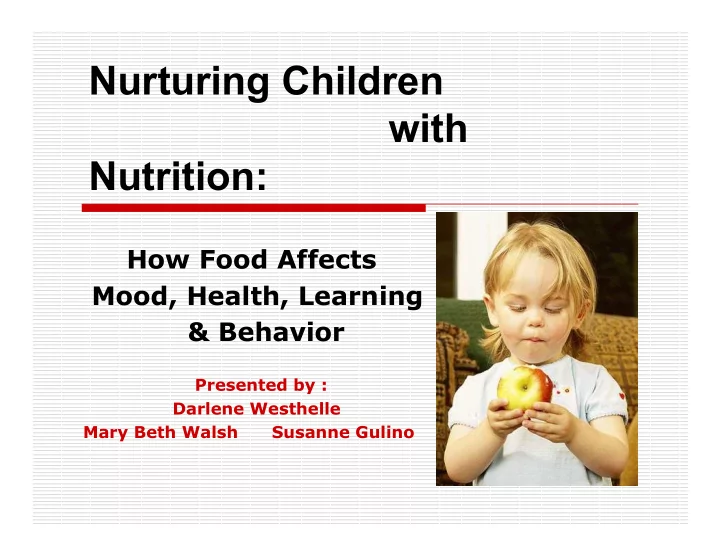

Nurturing Children with Nutrition: How Food Affects Mood, Health, Learning & Behavior Presented by : Darlene Westhelle Mary Beth Walsh Susanne Gulino
Let ’ s THINK and EVALUATE:
How many of these foods are in most children ’ s diets each day?
How many of these foods are in most children ’ s diet each day?
How much of this do children in your class drink each day?
How much of these do children drink each day?
Food affects mood. Mood Supporters Foods that produce o o Negative Mood Effects Vegetables o Sugar o Fruit o White flour o Cold Water Fish o Nuts o Beans o Non-fat yogurt o Eggs o (free-range, organic is best) Whole grains o
Omega 3s and Mood Low levels of DHA (formed from Omega 3s) are o associated with depression. Sources of Omega 3s include: salmon, mackerel, o sardines, walnuts, flax, pumpkin seeds, leafy greens and hemp seeds.
Food Affects Health Skin Nails Hair We ARE what we eat. Blood Organs Bones
Leafy greens are lacking in the Standard American Diet (S.A.D.) Leafy greens provide us with: Omega 3s , Vitamin A (carotenoids), B-complex vitamins, Vitamin C , Vitamin K , iron, calcium, zinc, iodine, magnesium, selenium, potassium, phosphorous and all trace minerals , as well as fiber.
How many of these phytochemicals that prevent disease are in your family ’ s diet? Phytochemical Actions Sources Lycopene Anti-carcinogenic Tomatoes, red grapefruit Isothiocyanates Inhibit cancer growth Broccoli, cabbage, cauliflower Isoflavones Block hormonally Soy beans and soy- stimulated cancers, derived foods lower cholesterol levels Anthocyanins Antioxidants, lower Berries, cherries, cholesterol, stimulate grapes, currants immunity Terpenoids Antioxidants, Peppers, cinnamon, antibacterial, prevent horseradish, rosemary, stomach ulcers thyme, turmeric
. . . and these? Phytochemical Actions Sources Flavonoids Anti-oxidants, anti- Broccoli, onions, carcinogenic, protect grapes, apples, against heart disease cherries, tomatoes Phenolic compounds Anti-oxidants, Nuts, berries, green protect against tea carcinogenic changes Sulfides Anti-carcinogenic, Garlic, onions, chives inhibit blood clots
How many phytochemicals do you think are in this meal?
Nutrition Facts from the Source: Source: http://app.mcdonalds.com/bagamcmeal?process=flash
Let ’ s look at an ingredients list.
Do these both qualify as “ fruit ” ? or
Ingredients to avoid: o High Fructose Corn Syrup/Sugar o Hydrogenated or partially hydrogenated oils=trans fatty acids o Artificial colors and flavors o Additives o Preservatives
High Fructose Corn Syrup/Sugar Sugars hide in “ not- so- obvious ” places. Ingredients : Unbleached Enriched Wheat Flour, Water, Whole White Wheat Flour, High Fructose Corn Syrup , Wheat Gluten, Cornmeal, Yeast, Salt, Monoglycerides, Preservatives (Calcium Propionate, Sorbic Acid, Guar Gum, Citric Acid, Soy Flour READ LABELS!!!
High Fructose Corn Syrup: Just Another Sugar or Worse? o The January/February 2008 issue of Nutrition Action reported that HFCS is no worse than sugar (but that sugar is harmful). ???? o The results of a study funded by the Center for Advanced Food Technology of Rutgers University that were presented at the 234 th annual meeting of the American Chemical Society , linked HFCS to diabetes in children.
Hydrogenated or Partially Hydrogenated Oils=Trans Fat o Raises LDL o Raises triglycerides o Lowers “ good ” HDL cholesterol o Makes blood cell fragments “ stickier ” and more likely to form blood clots. This adds up to the potential for heart disease. Trans fat has also been linked to cancer.
What nutrition is there in this cookie? Oreos Ingredients : Sugar* , flour, hydrogenated soybean oil , cocoa, high fructose corn syrup* , whey, corn starch, baking soda, salt, soy lecithin, vanillin (artificial), chocolate *Two types of sugar ingredients!
Typical Processed Foods Dunkin Donut 6 grams trans fat Burger King 5 grams trans fat French Fries Nabisco Oreos 2 grams tans fat McDonald ’ s Chicken 3 grams trans fat McNuggets Orville Redenbacher ’ s 3 grams trans fat Popcorn From Eat, Drink, and Be Healthy by Walter C. Willet, M.D. with Patrick J. Skerrett
Are there any of these in an Oreo? Phytochemical Actions Sources Lycopene Anti-carcinogenic Tomatoes, red grapefruit Isothiocyanates Inhibit cancer growth Broccoli, cabbage, cauliflower Isoflavones Block hormonally Soy beans and soy- stimulated cancers, derived foods lower cholesterol levels Anthocyanins Antioxidants, lower Berries, cherries, cholesterol, stimulate grapes, currants immunity Terpenoids Antioxidants, Peppers, cinnamon, antibacterial, prevent horseradish, rosemary, stomach ulcers thyme, turmeric
Food Affects Learning ScienceDaily (Jul. 25, 2006) — Poor nutrition o early in life can impair neural development , leading to lower IQ in humans and flawed song learning in birds. Recent evidence indicates that many organisms can offset some of the changes associated with early poor nutrition by modifying their physical development. For example, poorly nourished children can undergo a period of accelerated growth once their diet improves, ultimately appearing normal as an adult. But such compensatory measures may come at a price, with cognitive or other developmental disabilities emerging later in life.
The brain needs many different nutrients. o The neurons must be fed. o The body ’ s messengers, the neurotransmitters, are made from the amino acids in proteins . o Over half the brain is fat . Fat also regulates memory and mood (Omega 3s). o Carbohydrates provide the brain fuel. o Water is needed for concentration and mental alertness.
Food Affects Behavior o A carefully designed controlled study in the UK, found that common food dyes and a preservative (sodium benzoate) were found to increase hyperactive behaviors and inattention in three-year-olds and children eight and nine. o Sugar increases the release of adrenaline in children.
ADHD
They ARE what they eat.
Recommend
More recommend